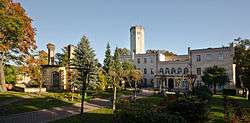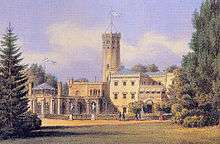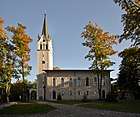Mysłakowice
Mysłakowice [mɨswakɔˈvit͡sɛ] (German: Zillerthal-Erdmannsdorf) is a village in Jelenia Góra County, Lower Silesian Voivodeship, in south-western Poland.[1] It is the seat of the administrative district (gmina) called Gmina Mysłakowice. It lies approximately 7 kilometres (4 mi) south-east of Jelenia Góra and 94 km (58 mi) west of the regional capital Wrocław. The village has a population of 5,100.
Mysłakowice | |
|---|---|
Village | |
 Chateau in Mysłakowice | |
 Coat of arms | |
 Mysłakowice | |
| Coordinates: 50°51′N 15°47′E | |
| Country | |
| Voivodeship | Lower Silesian |
| Powiat | Jelenia Góra |
| Gmina | Mysłakowice |
| Population | 5,100 |
| Time zone | UTC+1 (CET) |
| • Summer (DST) | UTC+2 (CEST) |
| Website | http://www.myslakowice.pl/ |
The village dates back to the Middle Ages. The oldest mention comes from the Liber fundationis episcopatus Vratislaviensis from around 1305, when it was part of the Duchy of Jawor of fragmented Piast-ruled Poland.

The village along with the region was annexed by the Kingdom of Prussia in the 18th century. The Prussian field marshal August von Gneisenau owned an estate here, where he lived during his retirement. King Frederick William III of Prussia visited him several times when staying with his brother Prince Wilhelm at Fischbach (today Karpniki), also located in the Jelenia Góra Valley, where the prince had acquired a castle in 1822. After Gneisenau's death the king purchased Erdmannsdorf estate in 1831 and had the manor house redecorated and a new church built by Karl Friedrich Schinkel. The church portico is supported by two marble columns from Pompeii, a gift from Joseph Bonaparte, King of Naples, to Frederick William III. In 1838 the king distributed large parts of his farmland to protestant refugees from the Austrian Zillertal who built Tyrolian style farmhouses that can still be seen. The valley became a royal hideaway, and in 1838 the king purchased nearby Schildau Castle (today Wojanów) for his daughter Princess Louise. His son Frederick William IV bought Erdmannsdorf from his stepmother Auguste, Princess of Liegnitz, and had it enlarged and redecorated in Tudor Revival architecture by Friedrich August Stüler from 1840. Next to the palace a Swiss style farmhouse was built for the Princess of Liegnitz. The park had been designed by Peter Joseph Lenné, offering wide views onto the Giant Mountains; both castle and park do still exist, however used by a school and in rather neglected condition. The famous views are concealed behind trees.
During World War II, in 1945, the Germans established and operated a subcamp of the Gross-Rosen concentration camp in the village, in which around 500 Jewish women worked as forced labour.[2] On February 17, 1945, the prisoners were evacuated to Gross-Rosen and Smržovka.[2]
After the defeat of Nazi Germany in the war, in 1945, the village became again part of Poland. Nowadays an elementary school is located in the historic palace.
Gallery
 Sacred Heart church
Sacred Heart church_jar.jpg) Old factory
Old factory.jpg) Street with old buildings
Street with old buildings- Park
References
- "Central Statistical Office (GUS) - TERYT (National Register of Territorial Land Apportionment Journal)" (in Polish). 2008-06-01.
- "Subcamps of KL Gross- Rosen". Gross-Rosen Museum in Rogoźnica. Retrieved 18 April 2020.
| Wikimedia Commons has media related to Mysłakowice. |